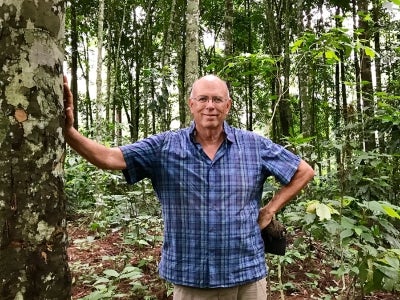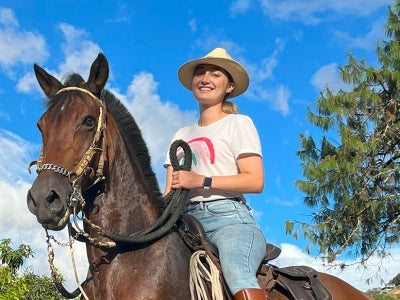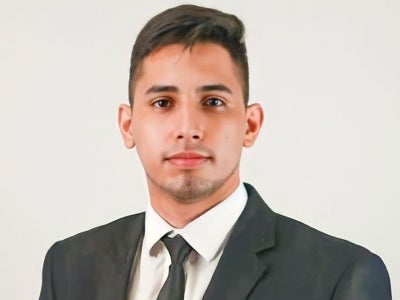
Photo courtesy of Mark Zimsky
Mark Zimsky wears two hats at the Global Environment Facility: he manages its biodiversity work globally, and its work in Latin America across all focal areas. In an interview, he reflected on how working on organic farms as a young man deepened and informed his interest in global environmental issues, and shared highlights from his more than 20-year career supporting GEF projects.
How did you get into this line of work?
During my high school years, a group of friends and I became interested in the “back to the land” movement of that era. There were many trailblazers during that time who were writing about the disconnect of people and nature, and “good work,” and the need to reconnect to nature to realize one’s full human potential. My friends and I began investigating lifestyles and jobs more in harmony with nature than what we saw our parents’ generation achieve. For me that led to leaving Pittsburgh and spending most of my 20s working on organic farms in California, apprenticing with master horticulturists to learn the art of vegetable, flower, and fruit production.
I was then offered the opportunity to join a team that was establishing an organic agriculture training center in Kitale, Kenya, at a former English boarding school. My time in Kenya was eye opening. It was the first time I had seen the challenges farmers in developing countries faced – not only with agricultural production, but also in the management of natural resources. Poor soils, limited access to fertilizers, challenges in accessing markets, and limited fuel options other than firewood required everyone to be creative and resilient.
I eventually realized that university training would help ground my practice in theory, and further deepen my knowledge. Upon returning to the United States, I earned a Bachelor of Science degree in Conservation and Resource Studies at the University of California, Berkeley as a mature student, and then received a Master’s degree in forestry from Yale University. From there, I worked on a few forestry and agricultural projects in Latin America and started consulting with UNDP, helping countries design and develop GEF-supported programs. This then led to an opportunity to return to Kenya to lead UNEP’s GEF biodiversity portfolio in Nairobi, and subsequently to joining the GEF Secretariat in Washington in 2004.
Could you describe a project you are currently focused on?
The beauty of working at the Global Environment Facility is that you must have the ability to focus on many issues and projects at once, so this question is hard to answer. One initiative I am currently working on is a package of grants to help developing countries quickly implement the upcoming Global Biodiversity Framework. Our early action support will include help to align national policies, biodiversity strategies, and action plans with the new international targets that are expected to be finalized this year in Kunming, China. Targeted financial support like this can make a big difference in countries’ ability to turn environmental goals into reality, and take action on a large scale.

Mark Zimsky speaking at the 9th Trondheim Conference on Biodiversity. Photo credit: IISD/ENB | Mike Muzurakis
Is there a GEF-supported project that is close to your heart?
I have been involved with designing, implementing, or reviewing GEF projects for more than two decades, so I have had the good fortune to be part of many amazing initiatives. I could easily list 25 projects that are close to my heart, but here are just a few:
- When working as a consultant for UNDP, I cut my teeth on a very early GEF program, the Meso-America Biological Corridor Program, which sought to address the drivers of biodiversity loss in Mesoamerica in a truly integrated way. Working on this program’s design and development provided me a glimpse of the potential of the GEF as both funder and convenor.
- More than 20 years later, I am on the steering committee for the Amazon Sustainable Landscapes Program, which is trying to address a similar set of drivers of environmental degradation and in an even more integrated way and on a much bigger scale, drawing upon a years of learning and relationships in the Amazon region and across the conservation sector.
- One of the first GEF-supported projects I worked on at UNEP, the Siberian Crane Wetland Project, pioneered the application of the flyway concept to migratory waterbird conservation – spanning the entire area covered by migratory birds on an annual basis, from breeding grounds to non-breeding areas, and their intermediate resting and feeding places. This project involved China, Russia, Kazakhstan, and Iran, with transboundary conservation and cross-cultural challenges that we were able to overcome.
- I have had the good fortune to work with many excellent civil society organizations working to develop solutions to conservation challenges. In 2015, in collaboration with the Zoological Society of London, I helped design a pilot project aimed at protecting rhinos and raising money from the private sector. The Rhino Impact Investment Project which was implemented by UNDP has proven that species-specific financial instruments can be successful and has opened the door to new ventures such as conservation bonds that can catalyze change on a larger scale.
What resonates most powerfully for me when reflecting on these projects, and my numerous trips to the field to assess implementation progress or to work with stakeholders on design workshops, is the incredible seriousness and dedication of GEF partners to advance biodiversity conservation, often against impossible odds and with limited resources. Their passion is infectious and inspiring.
What life lessons has your work taught you?
Working in the conservation field is a long game. You need to show up consistently and put in the effort every day for weeks, months, years, to make progress towards your goals.
Also, it’s better to be kind.
Environmental issues are very often complicated and concerning. What gives you hope?
The creativity and capacity of the human mind, and the ability we have demonstrated to evolve as a species and design solutions to seemingly intractable problems, gives me hope. It wasn’t so long ago we were living in caves.
What advice would you give a young person contemplating an environmental career?
While I still believe that multilateral organizations have an incredibly important role to play in advancing environmental conservation, I always advise young people not to follow my path. Young professionals who want to make a difference in the environmental sector today should pursue opportunities within the private sector, where they can exert greater impact more quickly as businesses work to reduce their environmental footprints and advance green products and services. At the start of my career, these opportunities were very limited but now there are an abundance of options to be a changemaker in the private sector for the benefit of the environment.
How has your idea of “good work” changed since your high school days?
Our collective dream back then was to live a life off the land, as the purest expression of E. F. Schumacher’s idea of good work. I aim to still arrive there after my career detour in biodiversity conservation. While my belief in the value of the idea of good work hasn’t changed, I’ve realized that being in service to others, and in cooperation with others, for a cause greater than yourself can take many forms — from contributing food to a community as an organic farmer to helping advance the cause of conservation.


